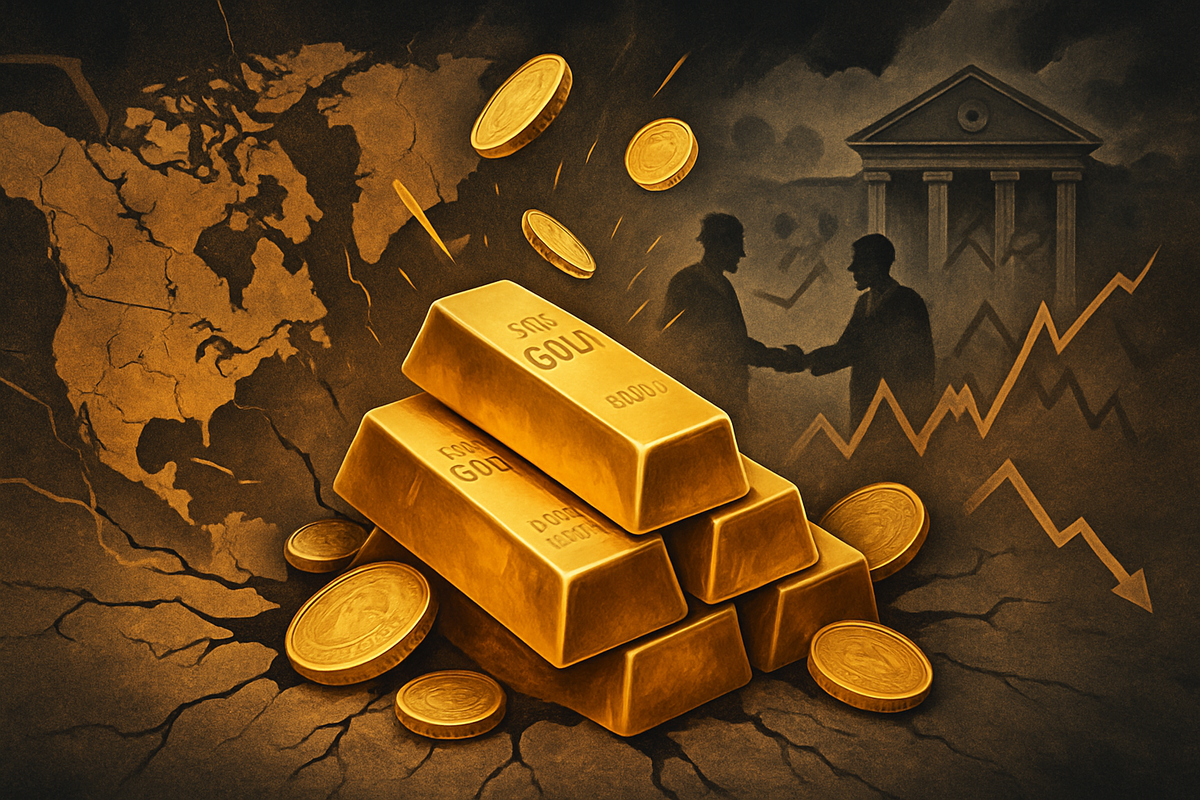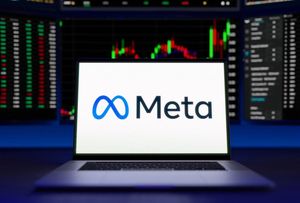
Gold prices have surged to unprecedented levels, with spot gold surpassing $4,300 per ounce and reaching peaks as high as $4,379.44 as of mid-October 2025. This remarkable rally, representing a 60-65% increase since the beginning of the year, is a clear indicator of profound uncertainty gripping global financial markets. The precious metal's ascent is fueled by a potent cocktail of escalating geopolitical tensions, persistent global trade woes, and growing market expectations for a significant dovish shift in the Federal Reserve's monetary policy, all set against a backdrop of uneven inflation and a softening U.S. labor market.
The record-breaking performance of gold underscores its enduring role as a safe-haven asset in times of economic and political instability. Investors are increasingly flocking to the yellow metal, hedging against a confluence of risks that range from a prolonged U.S. government shutdown to intensifying international conflicts and a strategic de-dollarization trend among global central banks. The Federal Reserve's anticipated interest rate cuts, aimed at stimulating a weakening economy, further enhance gold's appeal by reducing the opportunity cost of holding the non-yielding asset and potentially weakening the U.S. dollar.
The Perfect Storm: Geopolitical Tensions, Trade Woes, and a Dovish Fed Fuel Gold's Ascent
The current surge in gold prices to record highs is a direct consequence of a complex interplay of global events and policy expectations. Spot gold has consistently breached new thresholds, with futures contracts for October delivery also reflecting strong upward momentum, solidifying gold's status as a premier safe-haven investment. This rally has been building throughout 2025, accelerating significantly in recent months as a series of interconnected crises have unfolded.
A primary catalyst for gold's ascent is the severe geopolitical instability plaguing the global landscape. A protracted U.S. government shutdown, now in its third week, has injected considerable uncertainty into the world's largest economy, prompting investors to seek refuge in tangible assets. Simultaneously, U.S.-China trade tensions remain a potent force, with threats of higher tariffs from the U.S. on Chinese goods continuing to strain global economic relations. While recent comments from President Trump hint at renewed negotiations, the underlying risk of escalating trade wars persists. Beyond economic superpowers, ongoing conflicts such as the Russia-Ukraine war and heightened tensions in the Middle East, including the fragile Israel-Hamas ceasefire and the involvement of regional actors like Iran, contribute significantly to pervasive risk aversion. Adding to this, growing concerns over mounting government debt in the U.S. and other developed nations, alongside broader fiscal fragility, are eroding confidence in traditional fiat currencies, propelling investors towards gold as a more reliable store of value.
Global trade woes extend beyond direct tariff disputes, creating ripple effects that bolster gold demand. The imposition of new U.S. tariffs on Chinese imports is not only straining global economies but also leading to widespread supply chain disruptions. Manufacturing companies are increasingly utilizing precious metals to hedge against volatile input costs, with China's restrictions on rare earth exports serving as a stark example of these vulnerabilities. Furthermore, a discernible global trend of "de-dollarization" is underway, as numerous countries and central banks actively work to reduce their reliance on the U.S. dollar in international trade and as a reserve currency. This strategic diversification has led to unprecedented levels of gold accumulation by central banks worldwide, further strengthening gold's position as an alternative reserve asset.
Crucially, the Federal Reserve's evolving inflation outlook and anticipated monetary policy decisions are providing significant tailwinds for gold. Despite persistent efforts, inflation remains stubbornly above the Fed's 2% target, with the Cleveland Fed's nowcast for September 2025 indicating year-over-year CPI and core CPI both near 3%. While some market participants view recent upticks as temporary, the overall uneven progress on inflation, coupled with a visibly weakening U.S. labor market—marked by declining monthly job gains and the highest unemployment rate since 2021—is pushing the Fed towards a more accommodative stance. Market consensus points to a "dovish pivot," with expectations for a 25-basis-point interest rate cut at the upcoming October 28-29 FOMC meeting, following a similar reduction in September. Further cuts are anticipated in late 2025 and throughout 2026, potentially pushing the federal funds rate below 3%. This prospect of lower interest rates significantly enhances gold's attractiveness, as it reduces the opportunity cost of holding the non-yielding metal and typically leads to a weaker U.S. dollar, making gold more appealing to international buyers. The ongoing U.S. government shutdown has also created a "data blackout," forcing the Fed to make critical policy decisions with incomplete economic information, potentially increasing market volatility and reinforcing a proactive, yet risky, shift in the central bank's strategy.
Market Movers: Who Wins and Who Loses in a Golden Era
The sustained rally in gold prices, driven by global instability and anticipated monetary easing, creates a clear bifurcation in the financial markets, presenting significant opportunities for some companies while posing considerable challenges for others. The primary beneficiaries are, unsurprisingly, companies directly involved in gold mining and those providing safe-haven investment products.
Gold mining companies stand to gain substantially from elevated prices. Higher per-ounce revenues translate directly into improved profit margins, assuming production costs remain relatively stable or increase at a slower pace than gold's market value. Major gold producers such as Barrick Gold Corp. (NYSE: GOLD), Newmont Corporation (NYSE: NEM), and Agnico Eagle Mines Limited (NYSE: AEM) are poised to see increased earnings and cash flows. These companies can leverage higher prices to pay down debt, fund exploration and development projects, or return capital to shareholders through dividends and buybacks. Junior mining companies, often with higher operational leverage, could experience even more dramatic percentage gains in their stock prices as previously uneconomical reserves become viable and investor sentiment shifts towards growth in the sector. Furthermore, companies that produce silver and other precious metals may also see a halo effect, as these commodities often track gold's movements during periods of market uncertainty.
Conversely, the same factors driving gold's rise—namely persistent inflation and a weakening economic outlook—could negatively impact companies sensitive to rising costs and reduced consumer spending. Businesses with high input costs that cannot easily pass these onto consumers may see their profit margins eroded. This could include sectors like manufacturing, transportation, and certain consumer discretionary segments. Companies heavily reliant on stable global trade and supply chains could also face headwinds from ongoing geopolitical tensions and tariffs, which are contributing to gold's appeal. Furthermore, a weaker U.S. dollar, a potential consequence of Fed rate cuts, could make imported goods more expensive for U.S. companies and consumers, impacting industries that depend on global supply chains. Financial institutions, particularly those with significant exposure to interest rate-sensitive assets, might face challenges if the Fed's dovish pivot leads to compressed net interest margins, although this is a more nuanced impact. Companies holding large cash reserves in U.S. dollars might also see the purchasing power of those reserves diminish if the dollar weakens significantly against other major currencies or commodities like gold.
Broader Implications: Reshaping Economic Landscapes and Policy Directives
The record surge in gold prices is far more than just a market anomaly; it represents a significant indicator of broader shifts in global economic trends and carries substantial implications for regulatory policy, international relations, and historical economic paradigms. This event is not isolated but rather a symptom of deeply embedded anxieties regarding global stability and the future trajectory of monetary policy.
Firstly, the sustained demand for gold fits squarely into a broader industry trend of de-risking and diversification among institutional investors and central banks. The "de-dollarization" movement, where nations actively seek to reduce their reliance on the U.S. Dollar, is a profound shift with long-term consequences. Central banks, notably those in emerging markets, have been accumulating gold at an unprecedented pace, reflecting a strategic pivot away from traditional reserve assets and towards tangible stores of value. This trend challenges the long-standing hegemony of the U.S. dollar and could reshape global trade and financial architectures. The ripple effects on competitors and partners are evident: countries with substantial gold reserves may find increased financial stability and leverage in international negotiations, while those heavily reliant on dollar-denominated assets might face greater vulnerability to currency fluctuations and geopolitical pressures.
From a regulatory and policy standpoint, the gold rally places immense pressure on central banks, particularly the Federal Reserve. The Fed's anticipated dovish pivot, driven by a weakening labor market and persistent, albeit uneven, inflation, signals a complex balancing act. The fact that gold, traditionally an inflation hedge, is soaring simultaneously with expectations of rate cuts (which typically weaken the dollar and can be inflationary) highlights the market's skepticism about the Fed's ability to navigate these crosscurrents. Policymakers must now contend with the message gold is sending: that confidence in economic stability and traditional fiat currencies is waning. This could lead to increased scrutiny of monetary policy decisions and potentially encourage alternative economic strategies aimed at bolstering confidence in national currencies and fiscal health. Furthermore, the ongoing U.S. government shutdown, creating a "data blackout," complicates the Fed's ability to make informed decisions, potentially leading to policy missteps and further market volatility.
Historically, periods of significant gold price appreciation have often coincided with major geopolitical upheavals, high inflation, or a crisis of confidence in financial systems. For instance, the gold surges of the 1970s were linked to oil shocks and high inflation, while the run-up during the 2008 financial crisis reflected profound systemic fear. The current environment, characterized by a unique blend of geopolitical fragmentation, trade wars, and sovereign debt concerns, draws parallels to these historical precedents but also presents new challenges. The "de-dollarization" trend, for example, adds a dimension not as prominent in previous gold rallies. This historical context suggests that the current gold rally is not merely speculative but reflects deep-seated economic and political anxieties, signaling a potential paradigm shift in global finance rather than a fleeting market phenomenon.
The Road Ahead: Navigating a Volatile Golden Landscape
The current trajectory of record gold prices, propelled by geopolitical turbulence and a dovish Federal Reserve, sets the stage for a period of continued market volatility and strategic re-evaluation. Both short-term fluctuations and long-term structural shifts are on the horizon, presenting distinct challenges and opportunities for investors and policymakers alike.
In the short term, gold prices are likely to remain highly sensitive to incoming economic data, geopolitical developments, and Federal Reserve communications. Any unexpected escalation in U.S.-China trade tensions, further deterioration in the Middle East, or a prolonged U.S. government shutdown could provide immediate upward impetus for gold. Conversely, signs of de-escalation or a surprisingly hawkish stance from the Fed could trigger temporary pullbacks. However, given the entrenched nature of current global anxieties and the Fed's clear signal of a dovish pivot, significant downward pressure on gold seems unlikely in the immediate future. Investors should brace for continued price discovery, with potential for gold to test even higher psychological resistance levels as long as the underlying drivers persist. Market opportunities may emerge in tactical trading around these events, but the broader trend appears to be upward.
Looking further ahead, the long-term possibilities suggest a more profound reordering of global financial assets. The "de-dollarization" trend is a slow-moving but powerful force that could fundamentally alter the composition of global reserves, cementing gold's role as a cornerstone asset for central banks and sovereign wealth funds. This shift could lead to sustained demand for gold, independent of short-term economic cycles. Public companies, particularly those in the mining sector, will need to adapt strategically. Gold miners may focus on expanding production, optimizing costs, and securing new exploration territories to capitalize on higher prices. Companies in other sectors might need to reassess their supply chain resilience, currency hedging strategies, and overall exposure to geopolitical risks. The emergence of new market opportunities could also include increased innovation in gold-backed financial products and greater investment in alternative safe-haven assets.
Potential scenarios range from a "soft landing" where the Fed successfully manages inflation while avoiding a deep recession, to a more challenging "stagflationary" environment characterized by high inflation and low growth. In a soft landing, gold might stabilize but retain its elevated value due to ongoing geopolitical risks. In a stagflationary scenario, gold could see further significant gains as a primary hedge against both inflation and economic stagnation. A key outcome to watch is how global central banks respond to the de-dollarization trend; a coordinated shift towards multi-currency reserves or increased gold holdings could have lasting impacts on currency valuations and commodity markets. Investors should monitor central bank gold purchases, the evolution of U.S.-China relations, and the effectiveness of the Fed's monetary policy in taming inflation without stifling growth.
The Golden Horizon: A New Era of Financial Prudence
The current surge in gold prices to unprecedented levels marks a pivotal moment in financial markets, reflecting a complex confluence of geopolitical instability, global trade realignments, and a significant shift in central bank monetary policy. The key takeaway is that gold's rally is not merely speculative; it is a profound indicator of eroding confidence in traditional financial certainties and a strategic recalibration of risk by global investors and institutions.
Moving forward, the market will likely remain highly attuned to both macro-geopolitical developments and the Federal Reserve's actions. Gold's role as a safe-haven asset and an inflation hedge has been unequivocally reinforced, suggesting that its elevated status is likely to persist. Investors should assess their portfolios for adequate diversification and consider gold's continued utility in mitigating risks associated with currency debasement, persistent inflation, and geopolitical shocks. The "de-dollarization" trend, while gradual, represents a fundamental shift that could reshape global financial architecture, making gold an increasingly strategic asset for nations and individuals alike.
The lasting impact of this period could be a more diversified global reserve system and a heightened awareness of non-traditional risks in financial planning. What investors should watch for in the coming months includes any new developments in U.S.-China trade negotiations, the actual pace and magnitude of Federal Reserve interest rate cuts, the trajectory of inflation metrics (particularly core goods inflation), and the continued pace of central bank gold accumulation. Furthermore, any resolution or escalation of ongoing geopolitical conflicts will significantly influence market sentiment. This era calls for financial prudence, strategic asset allocation, and a keen eye on the evolving global economic and political landscape.
This content is intended for informational purposes only and is not financial advice






